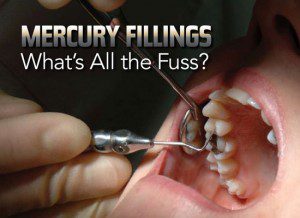Guest Writer for Wake Up World
Mercury is toxic to humans and dental amalgam fillings, which uses a 50% mercury base combined with other metals, is one of the most common types of exposure. Research proving the extensive damage mercury can cause to human tissue and brain function is why I advocate discontinuing their use and, if you have them, their removal. The following 10 facts expose the dangers of mercury amalgam and, after reading these, you will probably want to confirm what type of filling material your dentist uses – and possibly make a change!
1. Mercury Fillings Leak
Exposure to mercury from fillings results from erosion of the filling, or from evaporation from the surface of the filling. In one study, using a variety of X-ray imaging technologies, scientists examined the movement of mercury through the tooth. They found mercury in the tooth several millimeters away from the site of the filling. They also found higher concentrations of mercury in the area of the tooth, which connects with the gum, suggesting exposure to the blood stream. It was also found in the tartar on the teeth. [1] Conclusion? This stuff does not stay put!
2. Removing Amalgam Fillings Requires Caution!
At least, that’s the word based on a recent review of the filling removal process. The review noted the importance of proper patient preparation before and after the procedure to minimize exposure and ensure complete removal. [2] The goal is to prevent absorption of mercury during the process. It really begs the question why some dentist’s still use mercury amalgam?
3. Mercury is Immediately Toxic!
Mercury can enter the body through ingestion, the blood stream, and through inhalation. Once in the body, it is quickly absorbed and distributed to the major organs. The brain and the kidney suffer the greatest amount of damage. [3] And the damage doesn’t take a long time to develop.
A study of children 8-18 observed kidney damage in children with mercury amalgam exposure. They found chemical indicators of kidney damage in the urine of children with the dental amalgam. [4]
4. Mercury May Be Linked to Autism
The horrible effect that mercury has on the brain has been known for centuries and mercury exposure during key developmental stages has been linked to autism spectrum disorders. One study found that women with six or more amalgam fillings were 3x more likely to have children with severe autism compared to those with five or less fillings. [5]
5. Mercury Affects Hormone Levels
The damaging effects of mercury aren’t limited to the kidneys and brain; it also affects the adrenal system. Once absorbed into the blood stream, five potential consequences have been observed: [6]
- It accumulates in the organs that regulate hormone function.
- It damages the tissue of these organs.
- Hormone concentrations change.
- Mercury interacts specifically interacts with sex hormones.
- Enzyme production is affected.
Those are not the only problems; testosterone and mercury combine to create a toxic neurochemical. Estrogen appears to reduce the effect of mercury and offers some degree of protective effect. Researchers have suggested this difference may explain the difference in the way autism affects boys and girls. [7]
6. Men Are At Greater Risk
Although not related to autism, mercury’s effect on DNA function has also been shown to be gender specific. A survey among dental professionals evaluated the impact of regular exposure to mercury amalgam on DNA health. The study found the greatest negative impact on DNA function occurred in men. [8]
7. Mercury Harms the Thyroid
Seventy-five women-child pairs were evaluated for the impact of mercury exposure and thyroid function. The study covered the pre-natal through post-natal period. The results identified low-levels of mercury, such as those from amalgam fillings, to impact thyroid hormone levels. [9] A healthy thyroid is very important for development, especially neurological function, and this should be a red flag to any woman intending to have children!
8. Mercury Fillings Affect Oral Health
Amalgam fillings are toxic to mouth tissue. A study released earlier this year analyzed oral cells from 63 men and women. Independent of other factors such as alcohol and smoking, those with fillings containing mercury showed cellular and DNA damage. [10]
9. Mercury Amalgam is Dangerous to Children
Based on the research, mercury-based fillings for children can best be described as irresponsible. An ongoing study reported in 2012 that children with mercury fillings have increased levels of mercury in their body, year after year. The control group of children without fillings did not show this same rise. [11] Another study has linked several aspects of oral health, specifically burning-mouth sensation, ulcers, and white patches to the presence of mercury fillings. [12]
10. Medical Officials are Aware of All of This!
Medical officials have been aware of the dangers of mercury amalgam fillings for well over a decade. Records going back to 2001 report increasing levels of mercury in the liver, kidney, and brain in individuals with amalgam fillings. Researchers have even identified it in the amniotic fluid and placenta of pregnant women – and the meconium (the initial blackish poop) of newborn babies.
Even with the knowledge about the danger of mercury and mercury vapors, amalgam fillings have been used in children as young as 26 months, just past their 2nd birthday! [13] Before you or the children you love get another dental filling, be sure to ask your dentist what they use. If it’s a mercury amalgam, also called dental amalgam, request alternatives… or find another dentist!
-Dr. Edward F. Group III, DC, ND, DACBN, DCBCN, DABFM
Article References:
- Harris HH, Vogt S, Eastgate H, Legnini DG, Hornberger B, Cai Z, Lai B, Lay PA. Migration of mercury from dental amalgam through human teeth. J Synchrotron Radiat. 2008 Mar;15(Pt 2):123-8. doi: 10.1107/S0909049507061468. Epub 2008 Feb 19.
- Colson DG. A safe protocol for amalgam removal. J Environ Public Health. 2012;2012:517391. doi: 10.1155/2012/517391. Epub 2012 Jan 18.
- Park JD, Zheng W. Human exposure and health effects of inorganic and elemental mercury. J Prev Med Public Health. 2012 Nov;45(6):344-52. doi: 10.3961/jpmph.2012.45.6.344. Epub 2012 Nov 29.
- Geier DA, Carmody T, Kern JK, King PG, Geier MR. A significant dose-dependent relationship between mercury exposure from dental amalgams and kidney integrity biomarkers: a further assessment of the Casa Pia children’s dental amalgam trial. Hum Exp Toxicol. 2013 Apr;32(4):434-40. doi: 10.1177/0960327112455671. Epub 2012 Aug 14.
- Geier DA, Kern JK, Geier MR. A prospective study of prenatal mercury exposure from maternal dental amalgams and autism severity. Acta Neurobiol Exp (Wars). 2009;69(2):189-97.
- Tan SW, Meiller JC, Mahaffey KR. The endocrine effects of mercury in humans and wildlife. Crit Rev Toxicol. 2009;39(3):228-69. doi: 10.1080/10408440802233259.
- Geier DA, Kern JK, Geier MR. The biological basis of autism spectrum disorders: Understanding causation and treatment by clinical geneticists. Acta Neurobiol Exp (Wars). 2010;70(2):209-26.
- Goodrich JM, Basu N, Franzblau A, Dolinoy DC. Mercury biomarkers and DNA methylation among Michigan dental professionals. Environ Mol Mutagen. 2013 Apr;54(3):195-203. doi: 10.1002/em.21763. Epub 2013 Feb 26.
- Ursinyova M, Uhnakova I, Serbin R, Masanova V, Husekova Z, Wsolova L. The relation between human exposure to mercury and thyroid hormone status. Biol Trace Elem Res. 2012 Sep;148(3):281-91. doi: 10.1007/s12011-012-9382-0. Epub 2012 Mar 18.
- Visalli G, Baluce B, La Maestra S, Micale RT, Cingano L, De Flora S, Di Pietro A. Genotoxic damage in the oral mucosa cells of subjects carrying restorative dental fillings. Arch Toxicol. 2013 Jan;87(1):179-87. doi: 10.1007/s00204-012-0915-2. Epub 2012 Aug 8.
- Geier DA, Carmody T, Kern JK, King PG, Geier MR. A dose-dependent relationship between mercury exposure from dental amalgams and urinary mercury levels: a further assessment of the Casa Pia Children’s Dental Amalgam Trial. Hum Exp Toxicol. 2012 Jan;31(1):11-7. doi: 10.1177/0960327111417264. Epub 2011 Jul 29.
- Al-Saleh I, Al-Sedairi AA. Mercury (Hg) burden in children: the impact of dental amalgam. Sci Total Environ. 2011 Jul 15;409(16):3003-15. doi: 10.1016/j.scitotenv.2011.04.047. Epub 2011 May 20.
- Richardson GM, Wilson R, Allard D, Purtill C, Douma S, Gravià¨re J. Mercury exposure and risks from dental amalgam in the US population, post-2000. Sci Total Environ. 2011 Sep 15;409(20):4257-68. doi: 10.1016/j.scitotenv.2011.06.035. Epub 2011 Jul 22.
Recommended articles by Dr. Group:
- The 9 Best Herbs for Lung Cleansing and Respiratory Support
- The Benefits of Himalayan Salt
- How to Flush the Liver
- Lung Cleansing With Peppermint Oil
- The Benefits of Organic Hemp Milk + How to Make Your Own
- Nine Shocking Dangers of Fluoride Exposure
- 10 Natural Remedies for Kidney Stones
- 10 Foods That Detox the Body
- Seven Facts You May Not Know About Coconut Oil
About the author:
 Dr. Edward F. Group founded Global Healing Center in 1998 and is currently the Chief Executive Officer. Heading up the research and development team, Dr. Group assumes a hands-on approach in producing new and advanced degenerative disease products and information.
Dr. Edward F. Group founded Global Healing Center in 1998 and is currently the Chief Executive Officer. Heading up the research and development team, Dr. Group assumes a hands-on approach in producing new and advanced degenerative disease products and information.
Dr. Group has studied natural healing methods for over 20 years and now teaches individuals and practitioners all around the world. He no longer sees patients but solely concentrates on spreading the word of health and wellness to the global community. Under his leadership, Global Healing Center, Inc. has earned recognition as one of the largest alternative, natural and organic health resources on the internet.

If you've ever found value in our articles, we'd greatly appreciate your support by purchasing Mindful Meditation Techniques for Kids - A Practical Guide for Adults to Empower Kids with the Gift of Inner Peace and Resilience for Life.
In the spirit of mindfulness, we encourage you to choose the paperback version. Delve into its pages away from screen glare and notifications, allowing yourself to fully immerse in the transformative practices within. The physical book enriches the learning process and serves as a tangible commitment to mindfulness, easily shared among family and friends.
Over the past few years, Wake Up World has faced significant online censorship, impacting our financial ability to stay online. Instead of soliciting donations, we're exploring win-win solutions with our readers to remain financially viable. Moving into book publishing, we hope to secure ongoing funds to continue our mission. With over 8,500 articles published in the past 13 years, we are committed to keeping our content free and accessible to everyone, without resorting to a paywall.







